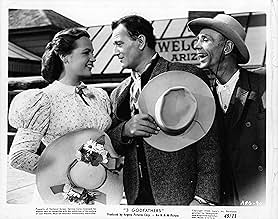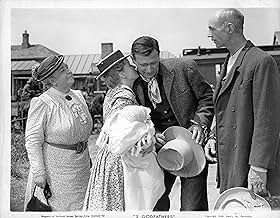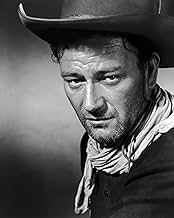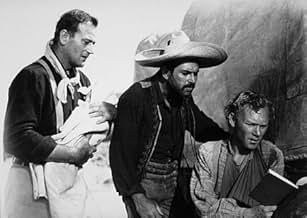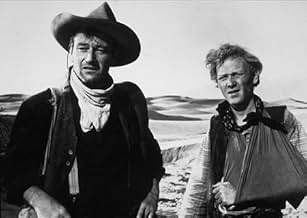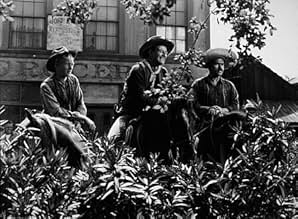IMDb रेटिंग
7.0/10
11 हज़ार
आपकी रेटिंग
अपनी भाषा में प्लॉट जोड़ेंThree outlaws on the run risk their freedom and their lives to return a newborn to civilization.Three outlaws on the run risk their freedom and their lives to return a newborn to civilization.Three outlaws on the run risk their freedom and their lives to return a newborn to civilization.
Pedro Armendáriz
- Pedro Roca Fuerte
- (as Pedro Armendariz)
Gertrude Astor
- Saloon Girl
- (बिना क्रेडिट के)
Nora Bush
- Townswoman
- (बिना क्रेडिट के)
फ़ीचर्ड समीक्षाएं
A really touching, naive, heart-warming Christmas movie, even if it may be quite a tear-jerker, especially at it's end: great cinematography - watch out for the wonderful impressions of the desert (the director of cinematography started with documentaries) -, great direction and one of John Wayne's best performances - this man was not only a big star, he was a wonderful actor, too!!! Between the end of the forties and the end of the fifties Ford knew how to lead Wayne to an artistic peak. And, not to forget of course: Hank Worden, Ben Johnson, Ward Bond, Pedro Armendariz, Harry Carey jr, ... what an ensemble did Ford build up around himself!!! Highly recommended to all those who want their hearts to be touched in rough times during a cold winter evening ...
I'm surprised this one doesn't get more accolades. To me it's really one of the best westerns ever made. This is one of those films that proves that the western genre can produce true art. The filming, the performances -- this is one of Wayne's best
it's quite overlooked that this guy could act: The desperation, the confusion, the exhaustion, it's all just amazing.
It's more of a character study than anything else, with the characters facing desperate thirst, an aching empty land, relentless sun, and the movie shows how these men deal with it, all the while they are attempting to care for a child. Something they are ill equipped to do.
There are clear religious elements to the movie, and they make this all the more compelling -- these are not good men, but they have a sense of honor and faith, in their own way. They can't break their word to a dying woman, to care for her child. Their faith in each other is touching.
It's gritty, yet very tender, a strange juxtaposition, like the beauty and cruelty of the desert.
See the movie if you can.
It's more of a character study than anything else, with the characters facing desperate thirst, an aching empty land, relentless sun, and the movie shows how these men deal with it, all the while they are attempting to care for a child. Something they are ill equipped to do.
There are clear religious elements to the movie, and they make this all the more compelling -- these are not good men, but they have a sense of honor and faith, in their own way. They can't break their word to a dying woman, to care for her child. Their faith in each other is touching.
It's gritty, yet very tender, a strange juxtaposition, like the beauty and cruelty of the desert.
See the movie if you can.
Redemption is the keyword to many a Ford work:this is perhaps the most convincing effort in a remarkable career for that matter.Like all the great auteurs,western is only an alibi for Ford to convey a message:God is the only way,the Bible is the only book for Man's education (as Dr Whatsisname's infant care manual for the new human being).
If you do not know anything about the screenplay and you expect a traditional western ,you may be disappointed:actually it might as well be a Xmas tale.Actually ,only the beginning and the ending are what you expect from a western.The central part is Robert's (Wayne) road to Damascus.His two pals do believe in God,he doesn't.The desert and the quest of water are a metaphor for the emptiness of his heart.In the second part of the movie,he's like the baby,busy being born.
Ford's movie is a visual splendor:the three men filmed against the sunlight near the mother's grave;the grave shot in close-up as the three men go away.The desert itself becomes an almost alive entity,filmed with a unique sense of space .Narration avoids readiness:when Wayne meets the mother,Ford does not show the scene:he lets his character tell it to his friends.The mother briefly appears for one short scene but she makes all her words count.
Singing is very important:when the mother is buried ,William sings over his grave but he cannot finish his canticle because he cannot remember the end:thus Ford avoids pathos and melodrama;when he rocks the baby,he sings "streets of Laredo",an ominous choice(but lullabies are sometimes strange and even cruel,aren't they?);the final choir "bringing in the sheaves" signals a brand new life for Robert. Towards the end ,the movie verges on fantastic ,which is extremely rare in the western genre.
Biblical quotations abound,but anyway,they are everywhere in Ford's work from the earlier works (the informer) to the later ones (seven women).
In the eighties,Coline Serreau made a shameless rip -off "trois hommes et un couffin".It wasn't a western ,the action taking place in Paris 1985,but a lot of ideas were taken from Ford .Besides,her three characters were despicable machos:One wishes it had not come from a woman .The movie was such a huge success that the American felt compelled to redo it (three men and a baby).Forget these mediocrities and do watch the Master 's tale of redemption.
If you do not know anything about the screenplay and you expect a traditional western ,you may be disappointed:actually it might as well be a Xmas tale.Actually ,only the beginning and the ending are what you expect from a western.The central part is Robert's (Wayne) road to Damascus.His two pals do believe in God,he doesn't.The desert and the quest of water are a metaphor for the emptiness of his heart.In the second part of the movie,he's like the baby,busy being born.
Ford's movie is a visual splendor:the three men filmed against the sunlight near the mother's grave;the grave shot in close-up as the three men go away.The desert itself becomes an almost alive entity,filmed with a unique sense of space .Narration avoids readiness:when Wayne meets the mother,Ford does not show the scene:he lets his character tell it to his friends.The mother briefly appears for one short scene but she makes all her words count.
Singing is very important:when the mother is buried ,William sings over his grave but he cannot finish his canticle because he cannot remember the end:thus Ford avoids pathos and melodrama;when he rocks the baby,he sings "streets of Laredo",an ominous choice(but lullabies are sometimes strange and even cruel,aren't they?);the final choir "bringing in the sheaves" signals a brand new life for Robert. Towards the end ,the movie verges on fantastic ,which is extremely rare in the western genre.
Biblical quotations abound,but anyway,they are everywhere in Ford's work from the earlier works (the informer) to the later ones (seven women).
In the eighties,Coline Serreau made a shameless rip -off "trois hommes et un couffin".It wasn't a western ,the action taking place in Paris 1985,but a lot of ideas were taken from Ford .Besides,her three characters were despicable machos:One wishes it had not come from a woman .The movie was such a huge success that the American felt compelled to redo it (three men and a baby).Forget these mediocrities and do watch the Master 's tale of redemption.
Like The Maltese Falcon, 3 Godfathers had to be made three times before we got the definitive version. This one has to rank at the top of John Wayne's films.
Wayne and fellow outlaws Pedro Armendariz and Harry Carey, Jr. arrive at the town of Welcome, Arizona and after a brief chance meeting with the marshal, Ward Bond, proceed to rob the Welcome bank.
In pursuit of the robbers, Bond shoots the waterbag draped across Wayne's saddle. And then he cleverly stations men at the few sources of water. Nevertheless the three outlaws decide to chance it across the desert.
Life takes a peculiar turn for them as they come across a dying Mildred Natwick who has just delivered an infant. Before she goes she exacts a promise from them to rescue her baby.
Even though their own freedom is at stake, Wayne, Armendariz, and Carey subordinate it to the care and rescue of the infant. At this point the Christmas parable takes over. The three wise men setting out with the infant in their charge to the nearest town which happens to be New Jerusalem, Arizona.
I said on another review of a Wayne film that John Wayne had one of the greatest faces for movie closeups ever. Check some of them here, especially during the desert trek. They say more than 10 pages of dialog. Ford, Hawks, Wellman all the great directors who worked with the Duke knew that and took advantage.
Pedro Armendariz and John Ford came to blow up on the set of 3 Godfathers according to Harry Carey, Jr.'s memoirs. Armendariz almost walked off the film. He finished it though and was great as the fatalistic Mexican outlaw. But he never worked for Ford again.
Although he'd done a few films before this, John Ford had in the credits, introducing Harry Carey, Jr. Of course the film is dedicated to his father who in fact had starred in the original silent Three Godfathers. Maybe this should have really been his debut film, Dobe Carey is just fine as the callow youth, The Abilene Kid.
This also marked the last film of veteran actor Guy Kibbee. As the practical and perceptive judge who tries Wayne, Kibbee is given a fitting swan song to a great career as a player.
This is certainly a more religious work than John Wayne is used to doing. Wayne, although he was baptized Catholic at the end of his life was not a particularly religious man. I do wonder if he had lived another decade what he would have made of the religious right.
Ford of course got in his obligatory Shall We Gather At the River, but also Bringing in the Sheaves was sung. And in the scene where a dehydrated John Wayne arrives at a saloon in New Jerusalem, the piano player is first playing The Holy City and then Silent Night. All to great effect by the way.
I think people that are not necessarily fans of the Duke will be amazed at the heights he rose to as a player in 3 Godfathers.
Wayne and fellow outlaws Pedro Armendariz and Harry Carey, Jr. arrive at the town of Welcome, Arizona and after a brief chance meeting with the marshal, Ward Bond, proceed to rob the Welcome bank.
In pursuit of the robbers, Bond shoots the waterbag draped across Wayne's saddle. And then he cleverly stations men at the few sources of water. Nevertheless the three outlaws decide to chance it across the desert.
Life takes a peculiar turn for them as they come across a dying Mildred Natwick who has just delivered an infant. Before she goes she exacts a promise from them to rescue her baby.
Even though their own freedom is at stake, Wayne, Armendariz, and Carey subordinate it to the care and rescue of the infant. At this point the Christmas parable takes over. The three wise men setting out with the infant in their charge to the nearest town which happens to be New Jerusalem, Arizona.
I said on another review of a Wayne film that John Wayne had one of the greatest faces for movie closeups ever. Check some of them here, especially during the desert trek. They say more than 10 pages of dialog. Ford, Hawks, Wellman all the great directors who worked with the Duke knew that and took advantage.
Pedro Armendariz and John Ford came to blow up on the set of 3 Godfathers according to Harry Carey, Jr.'s memoirs. Armendariz almost walked off the film. He finished it though and was great as the fatalistic Mexican outlaw. But he never worked for Ford again.
Although he'd done a few films before this, John Ford had in the credits, introducing Harry Carey, Jr. Of course the film is dedicated to his father who in fact had starred in the original silent Three Godfathers. Maybe this should have really been his debut film, Dobe Carey is just fine as the callow youth, The Abilene Kid.
This also marked the last film of veteran actor Guy Kibbee. As the practical and perceptive judge who tries Wayne, Kibbee is given a fitting swan song to a great career as a player.
This is certainly a more religious work than John Wayne is used to doing. Wayne, although he was baptized Catholic at the end of his life was not a particularly religious man. I do wonder if he had lived another decade what he would have made of the religious right.
Ford of course got in his obligatory Shall We Gather At the River, but also Bringing in the Sheaves was sung. And in the scene where a dehydrated John Wayne arrives at a saloon in New Jerusalem, the piano player is first playing The Holy City and then Silent Night. All to great effect by the way.
I think people that are not necessarily fans of the Duke will be amazed at the heights he rose to as a player in 3 Godfathers.
I can't say much for the storyline of 3 Godfathers as much as I can say for its visuals and imagery. For many, it is an allegorical tale with its heavy use of the Bible and other symbols throughout. However, I had a problem with the realism of the story, something this kind of plot needs to rely heavily on. Here we have three rough and tough men, by no means weak or unable to take care of themselves. Still, what they go through in this film along with trying to take care of a newly born infant, it boggles my mind as to how it is possible and perhaps it isn't.
I think I am reading too much into this and am missing the point John Ford was trying to make. So, I will try to understand the movie in its simplest terms. That would be that Ford was a master of imagery and using it to further the story. Here, every shot of the desert and swirling winds captures perfectly the atmosphere and mood, making the audience feel as if they are in the desert. It is most effective and does pick up some of the slack such as when the three men are first taking care of the infant or the final ten minutes in deciding Wayne's fate. All in all, this is not one of the great Ford Westerns. But, it shows once again his ability to control the mood and tone of his films and that can go a long way in providing leverage to an audience.
I think I am reading too much into this and am missing the point John Ford was trying to make. So, I will try to understand the movie in its simplest terms. That would be that Ford was a master of imagery and using it to further the story. Here, every shot of the desert and swirling winds captures perfectly the atmosphere and mood, making the audience feel as if they are in the desert. It is most effective and does pick up some of the slack such as when the three men are first taking care of the infant or the final ten minutes in deciding Wayne's fate. All in all, this is not one of the great Ford Westerns. But, it shows once again his ability to control the mood and tone of his films and that can go a long way in providing leverage to an audience.
क्या आपको पता है
- ट्रिवियाJohn Wayne was badly sunburned while filming this movie and was briefly hospitalized.
- गूफ़Shortly after the three riders enter the desert Hightower discovers that Pedro's water bag is empty and throws it away. As they ride away in a long shot, the water bag is still visible on Pedro's horse.
- भाव
Pedro "Pete' Roca Fuerte: [dying] Hey, Bob... I just remembered what tomorrow is. Feliz Navidad.
- साउंडट्रैकBeautiful River (Shall We Gather at the River)
(uncredited)
Written by Robert Lowry and Charles Ives
Performed by Harry Carey Jr.
टॉप पसंद
रेटिंग देने के लिए साइन-इन करें और वैयक्तिकृत सुझावों के लिए वॉचलिस्ट करें
- How long is 3 Godfathers?Alexa द्वारा संचालित
विवरण
- रिलीज़ की तारीख़
- कंट्री ऑफ़ ओरिजिन
- आधिकारिक साइटें
- भाषाएं
- इस रूप में भी जाना जाता है
- Tres hijos del diablo
- फ़िल्माने की जगहें
- उत्पादन कंपनी
- IMDbPro पर और कंपनी क्रेडिट देखें
बॉक्स ऑफ़िस
- बजट
- $12,43,000(अनुमानित)
- चलने की अवधि1 घंटा 46 मिनट
- पक्ष अनुपात
- 1.37 : 1
इस पेज में योगदान दें
किसी बदलाव का सुझाव दें या अनुपलब्ध कॉन्टेंट जोड़ें



